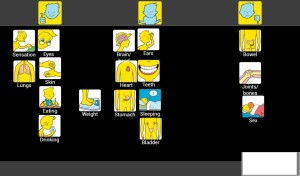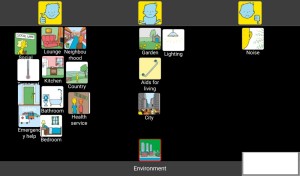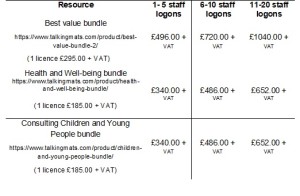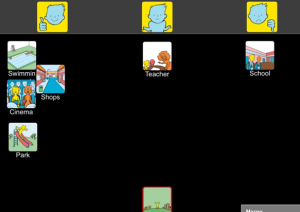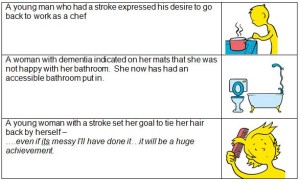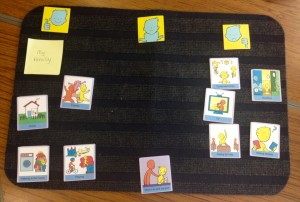We are very grateful to Elena Maxheimer, a Speech and Language Therapy student from Germany, for sending us this blog of a summary of her thesis which examined the use of the German Digital Talking Mats with people with aphasia.
In May 2018 I did my bachelor thesis on the German version of the Talking Mats app. Under the consultation of Prof. Dr. Norina Lauer, I delivered two workshops for eight people with aphasia. In these workshops the participants practiced doing Talking Mats and afterwards they evaluated the app by filling out a short questionnaire and taking part in a focus group in which they discussed the app’s content and practical use.
The participants generally rated the app as useful for people with aphasia and in particular, the topics, pictures and terms were rated as suitable for people with aphasia. The two most chosen topics were Health and Communication. Some aspects were difficult for people with aphasia. Some of the group had problems in choosing a suitable scale, writing on an empty card or writing down comments.
Suggestions for modification were
– Showing two sessions of Talking Mats parallel to have a better comparison
– Using the app on the smartphone – however the screen on a smartphone is too small to be manageable
– Saving the login data, so you don’t have to login every time you use the app
– One older participant suggested additional topics about specific diseases such as diabetes
– Another younger participant wanted more about sex, feelings, sympathy and love.
For other information about Talking Mats in Germany click here
Also Joan Murphy and Norina Lauer will be running a Talking Mats workshop in Cologne on May 5th and 6th 2019
Talking Mats received funding from The Health and Social Care Alliance Scotland to look at how using the Digital Talking Mats can help people with long term conditions, including dementia, to manage their health and well-being and to recognise their own strengths and abilities. We also hoped that participants would be able to have more control over their lives and have improved communication with families and professionals.
11 people living with dementia and their partners were involved in the project. Each participant had a tablet device and was given a personal digital Talking Mats licence which gave them access to 13 topics in the Talking Mats Health and Well-being resource. We visited each participant at home, taught them how to use it and asked them to complete at least 1 digital Talking Mat per week for 6 weeks on any topic they wished. The design of the digital Talking Mat allowed them to email their mats directly to us. We visited each participant a second time to discuss how easy it was to use the digital Talking Mats and their views on their completed mats. We asked those who wished to, to continue sending us completed mats beyond the initial 6 weeks and we visited them again in 6 months to discuss how they were managing.
In total we received 94 digital mats across all 13 topics from the participants living with dementia who reported that the use of the Digital Talking Mats during this project gave them a better understanding of their own individual health and social care needs.
A woman with dementia said ‘It (Health mat ) made me realise things are not so bad and made me think I will continue with my exercise classes, carry on walking, socialising and eating well’
As well as helping participants self-manage their lives, an unexpected outcome of this project was that many people found that using the Digital Talking Mats helped them see the positive things in their life and not just the negative. It also highlighted that despite having a deteriorating illness, things were not getting worse.
‘This mat (Environment) showed me how happy I am in my own home and my neighbourhood’
The following are some of the comments we received throughout the project.
• It helps me sort out my thoughts – very useful
• I get so much out of the process
• I come up with insights which might help me in the future
• I can now talk to (my wife) in a way I couldn’t before
• I’m more relaxed now
• I come up with niggly health things that my partner didn’t know
‘It made me realise things are not so bad’.
If you know of anyone living with dementia would like to obtain the Digital Talking Mats please fill in the attached Personal Digital Licence 161117 DTM personal licence form with explanation and send it to us at info@talkingmats.com
The Talking Mats digital app is available for organisations to purchase. This is an efficient way to support staff to evidence person centred planning.
The digital app typically operates via individual logons which means personal data is kept securely and it complies with data protection and client confidentiality. The individual with the logon can use their Digital Talking Mat with as many client/patients as they want.
We recognise that organisations may want to purchase several logons for staff to access digital Talking Mats and for that reason have created an Organisational Talking Mats digital licence. The savings are significant.
For application criteria please contact the Talking Mats office on 01786 479511
Why does Talking Mats work so well with children and adults with Down syndrome?
We have a great bit of video footage of Keir, a boy with Down’s syndrome, aged 9 years. He is using Talking Mats to talk about his life. Although Keir’s expressive speech is understood by his immediate family it can be harder for unfamiliar people to follow. Keir was able to communicate very clearly using his Talking Mat about what was going well and not so well. He used Makaton and key words to elaborate on some of his responses.Below is Keir’s Talking Mat. It looks like it would be good to do a submat on school.
We started to think about why Talking Mats can be such a great support for people with Down syndrome.
Here are our top ten reasons !
- In Down syndrome visuo-spatial processing is often viewed as a strength. Talking Mats uses a visual approach to communication.
- Receptive language skills are often better than expressive language skills. Talking Mat allows a thinker to express themselves visually talking the pressure off expressive speech.
- Vocabulary skills are often regarded as a strength and the Talking Mats framework relies on conceptual understanding.
- Talking Mats allows for extra processing time and space for the thinker to place the image on the mat. Reviewing the mat helps with auditory memory problems.
- The interviewer can then use the mat for conversation recasting (modelling a complete sentence) – so what you told me is……” You love going swimming because you like jumping in the water”
- Talking Mats allows you to explore topics that are of interest to the child or adult as well as topics that are functionally relevant.
- The Talking Mats images have words. A whole word approach can help literacy development. Symbols and words can also prompt speech production.
- Open questions are used which help to facilitate expression.
- Talking Mats can be used in lots of different settings: at home, in school and in the community.
- A Talking Mat conversation is FUN and supports relationship building and social closeness.
We know that every person with Down’s syndrome is a unique individual and we want to support them to further their communication, develop their interests, and become as independent as possible. Talking Mats is a great tool – why not give it a go. There’s lots more information on resources and training on www.talkingmats.com.
Self-management for people with long term conditions (LTC) is now a key government strategy to encourage people to take responsibility for their own health, behaviour and well-being. Talking Mats received funding from The Health and Social Care Alliance Scotland to look how using the Digital Talking Mats (DTM) can help people with LTCs to manage their health and well-being and to recognise their own strengths and abilities.
The overall aim of our project was to empower people with different long term conditions, to manage their own health and well-being. Through using Digital Talking Mats (DTM) we hoped that participants would be able to have more control over their lives and have improved communication with families and professionals.
There were a total of 28 participants in this project living with one of three different long term health conditions – stroke, dementia and learning disability. Each participant had access to a tablet device and was given a personal DTM licence which gave them access to 13 topics in the Talking Mats Health and Well-being resource. We visited each participant at home and taught them how to use it and asked them to complete and send us at least 1 digital mat per week for 6 weeks on any topic they wished. The design of the digital Talking Mat allowed them to email their mats directly to the researchers. We visited each participant a second time to discuss on how easy it was to use the digital Talking Mats and their views on their completed mats. We asked those who wished to, to continue sending us completed mats beyond the initial 6 weeks. We visited them again in 6 months to discuss how they were managing.
15 participants completed all 6 mats and 12 participants continued to complete mats over the length of the project. Participants completed 235 digital mats across all 13 topics
There were 3 particularly significant findings
1. At 18 months the participants living with dementia actually felt their well-being had improved, despite dementia being a progressive illness.
2. For the participants living with stroke the results were even more striking as 95% felt things were going well at the end of the project in comparison with 47% at the beginning.
3. At the end of the project the percentage of people with learning disability who felt things were not going well had reduced from 19% to 10%. Furthermore the percentage of people indicating that they were not sure about their views had increased from 27% to 42%. There can be a tendency for people with learning disability when using Talking Mats, to express their views at either end of the mat and to rarely use the mid- point. However being able to use the unsure mid- point is noteworthy as it indicates that the participants in the project realised that they could express their views not only as black or white but could indicate that they were unsure. This awareness opens up the potential for people to express views more thoughtfully with opportunities for further exploration.
Here are three examples of how using the DTM supported people to self-manage situations in their lives. Click on image to enlarge.
As well as helping participants self-manage their long term conditions, an unexpected outcome of this project is that many people found that using the DTM helped them see the positive things in their life and not just the negative. It also highlighted that despite having a long term condition and, for many also a deteriorating one, that things were not getting worse.
Click here for full report including 6,12 and 18 month reports to the funders 20180717 Alliance full report
Click here for the summary report 20180717 Alliance Final Short Report
Click here for a video link of 2 participants
Moving from a primary school to secondary school can be a daunting prospect for children.
Whilst schools understand the need to prepare the children for the transition process, due to time constraints, the focus tends to be on group visits to the new school rather than one to one support for individual children.
The challenge therefore is to ensure that each child feels prepared for the transition and that they have the opportunity to talk about any worries they may have.
My sister is a head teacher of a small village school and was interested in finding out more about her pupil’s experience and thoughts about their impending move to secondary education.
With the permission of parents I offered a Talking Mats session to each child in the term prior to them leaving for secondary education. In total this was 8 children.
I used digital Talking Mats, choosing the “What I do and support” topic cards from the primary school pack.
The children were told that we were going to think about how each topic may be affected by moving up to secondary school. We used a happy/not happy top scale.
The level of engagement from the children first amazed me. They were all excited by the prospect of using the digital Talking Mat. All were familiar with iPad use and grasped the concept quickly.
They used the topic cards to think about areas such as playing, friends, helping in the house, looking after yourself, your safety and managing stress.
They all expressed worry about the transition process but for many it was not around areas that teachers or parents would have automatically considered. How they were going to get to and from the new school was a theme that concerned them, as well as getting up and getting ready to go to school in the morning. A large number of the children also explained that they had poor sleep due to either difficulty getting off to sleep or waking with worries. Some children also disclosed some concerns about family life.
I found that the diverse nature of the cards prompted the children to think about areas of their life that their teachers had not ordinarily thought about when considering the impact of transition.
As an occupational therapist it struck me that many of the children were expecting that with the change from primary to secondary there also came the added responsibility of having to look after themselves. For them the transition was not just about moving schools it was also about being more “grown up” and being less reliant on their parents for prompting their self care routine or accompanying them when outside.
At the end of the session a summary was agreed with each child and this was sent to both the teacher and the parent so that they could support the child with the issues they raised. The teachers remarked that even though each session had only lasted 20 minutes, and was facilitated by someone the child had never met before, it had managed to reveal a breadth of information about how each child was feeling, that they were not previously aware of.
In summary, the beauty of the Talking Mats approach is that it allows the thinker to explore a range of issues that are relevant to them and does not lead the listener down a path of asking questions they think to be relevant. This gave the child I worked with the opportunity to really say what was troubling them. They were not put off by the fact they have never met me before, they talked freely with the digital version of the Talking Mat being both a point of focus as well as in a format they enjoyed.
Whilst the theme of the sessions in this case was transition, I would commend teachers to consider using Talking Mats in schools to enable children of all ages to think and communicate their feelings on a wide range of topics.
Thanks again Rachel Woolcomb OT for a great practical example.
We are grateful to Rachel Woolcomb OT, for sharing this Talking mats story.
Within my occupational therapy practice I have found Talking Mats to be an excellent thinking tool to help my clients establish their priorities for therapy.
I was asked to work with a teenage girl who had sustained a brain injury resulting in a mild cognitive impairment which was impacting on her participation and ability to learn at school.
She had undergone formal cognitive testing with a clinical psychologist, however had shown poor levels of engagement with the assessment process (which had taken over two hours). She was reported as having erratic focus and inconsistent answers to questioning. The results were therefore deemed to be inconclusive and no recommendations made. I knew that Talking Mats would provide me with similar information to that which the psychologist was trying to gain, but in a way that would be engaging and client focused. I also felt that the concept of the Talking Mat, which enables the thinker to express their own views rather than a “right or wrong” answer, would help to improve participation.
I selected the learning and thinking topic cards from the communication set within the Health and Wellbeing pack. These cards cover areas that I would normally look at within any cognitive assessment and are functionally relevant. Together we selected the visual scale, choosing the question “how well are you managing?”
She explained that organising herself, writing, listening, reading, problem solving and planning were all going well. She talked about how she sometimes had difficulties concentrating and paying attention due to getting distracted in the classroom. She also felt she was struggling more than before with calculating and that this was affecting her scores in Math tests. She explained that remembering and making decisions were “not going well’ and she was particularly worried about the fact she had forgotten some of the teaching she had received prior to her brain injury. I was also able to conclude from the way she understood the concept of the mat, as well as her ability to engage and attend for the whole session, that she could concentrate, learn new skills and had the ability to weigh up information to help her make decisions.
Together we used the information gained from the Talking Mat to set goals for therapy which were focused around having a range of strategies to help her concentrate in class, remember new information, and make decisions.
Two months later, once having completed a therapy programme, we used the Talking Mat again to explore her current thinking about the topic area. She explained that making decisions was something she no longer had difficulty with as her confidence had grown. She felt that there had been some improvement with her ability to remember information and we discussed the strategies she now used to help her concentrate in class, which included ways to minimise any distractions.
In summary, the Talking Mat enabled her to think about how her brain injury had affected her ability to remember, make decisions and learn. This provided valuable information from which a therapy programme could be created. The Talking Mat also provided a visual representation of her perception of the issues before and after therapy, showing clearly her progress. This was well received by her parents, teachers and the other professionals involved in her care.
Once again I have been amazed by the power of the Talking Mat to produce a breadth of information in a relative short space of time and I will be advocating its use within cognitive assessment and rehabilitation across all ages.
It was great to be able to attend the Intermediaries for Justice Conference on the 9th May in City University London. From the very beginning there was a real buzz of excitement in the room. Intermediaries demonstrated throughout the day their commitment and passion for their job despite frequently working in difficult circumstances as well as having a role that is not always appreciated. They are employed by the crown, magistrates and family courts in England, Wales and Northern Ireland. Intermediaries support two way communication between personnel involved in the justice system supporting those previously judged incapable of giving clear and effective evidence to do so.
There was a real buzz from the outset at the conference. At times, it can be quite a lonely role being an intermediary. If you get the role right and put the appropriate communication scaffolds in place, everyone communicates well – then some in the justice system find it hard to recognise that you have done anything at all! Baroness Newlove, the victims commissioner for England and Wales who was one of the key note speakers said ‘You need to see how intermediaries work to believe what they do ‘ Being a skilled communicator and being creative is the bedrock of intermediary practice. Baroness Newlove was clear that there needs to be greater access to registered intermediaries and but also there were clear management and long term support issues that need to be addressed by government.
The theme by various speakers throughout the day was the challenge of communication in the justice system. As one speaker put it ‘Justice is being delivered in a system designed in the 18th century which makes it difficult to fit the needs of the 21st century and ensure all have access to legal process ‘ Another speaker spoke of registered intermediaries levelling the playing field but there is still not equal access as defendants do not have automatic access to the scheme . As well as communication difficulties arising through the child’s age and or the person’s disability the issue of cultural communication was raised particularly in relation to gang culture
The conference loved meeting Oliver – the first dog in Europe trained to be court friendly and whose role is to support children to give evidence . Research in America has shown that stroking pets can help reduce fear and support children in court
Talking Mats is a communication framework that some intermediaries use . One said she could not do the role without Talking Mats and two intermediaries have described their use of them in two previous blogs . Click to read a blog by Nicola Lewis https://www.talkingmats.com/assisting-vulnerable-people-to-communicate/ and one by Catherine O’Neil https://www.talkingmats.com/talking-mats-used-court/ . So Talking Mats was delighted to be asked to the conference to have a stand and run a workshop. It was great to have Aileen O’Hagan with us and she talked through some case examples when she had used Talking Mats in her role as a intermediary. One example involved working with a young person with selective mutism where Aileen used Talking Mats to great effect to help prepare and plan for her witness interview . She created options around the optimum environment for the interview e.g. lightening, seating etc but also options around the mode of giving evidence . The witness wanted to write things down and wanted the intermediary to speak them out loud.
The day left me in no doubt that intermediaries are effective in enabling the voice of those who would not otherwise be heard, be heard. I remain concerned and puzzled as to why Scotland does not have the scheme. We do have appropriate adults but this role does not have the legal standing nor the training and qualification demands of the registered intermediary scheme and in practice the focus of the work is different . I hope this situation will change.
The intermediaries for justice organisation have now established themselves as a charity and if you want to find more about their work then visit http://www.intermediaries-for-justice.org.
If you are an intermediary and have found Talking Mats helpful then we would love to hear form you. We are always up for more guest blogs so please get in touch
One of the reasons why Talking Mats works is because it reduces the demand on the ‘thinker’ to remember the question, find the vocabulary needed to answer, construct the answer into a sentence, and then say it clearly. This reduced demand allows more ‘thinking time’.
Here’s a link to our website with more reasons why Talking Mats works
https://www.talkingmats.com/about-talking-mats/#whyitworks
Another reason people respond well to it is there is no right or wrong answer. It is not a test.
Sometimes the listener can forget their role and use the interaction as a test or as a language exercise. E.g . ‘Do you know what this picture is? ‘What’s this one called?’ This makes the demands on the thinker instantly increase as they are required to formulate an answer. Checking the persons level of understanding first may be necessary but it shouldn’t be done as part of the Talking Mat.
In our training we recommend avoiding ‘why’ questions , as they can make a person feel they have made an error. If the listener wants to know more, then a sub mat can be done
Our mission statement is to maximise the person’s capacity to express what they think. Let’s help them to do that!
Thanks to Laura Holmes for this blog about the support she gets from Talking Mats for ‘Learning Conversations’ with the children she works with.
I use Talking Mats for a variety of purposes in my role as a Speech and Language Therapist (SLT) for NHS Stockport Children’s Therapy Services Team, working with children with speech, language and communication needs (SLCN) in mainstream primary schools.
The introduction of the SEND Reforms in 2014 and SEND Code of Practice (January 2015) firmly places children and young people at the centre of the planning process – ‘No Decision About Me, Without Me’. The following principles underpin the reforms,
- Support for children and young people with SEND should be based on an understanding of their views, wishes and feelings.
- Wherever possible, children, young people and their parents should participate in decision making, and should be supported to participate.
- Support should help children and young people achieve the best possible outcomes, and prepare them for adulthood. (Howe C., et al 2016)
One of the main advantages of the Talking Mats approach is that it has enabled me to have ‘learning conversations’ with some of the children I work with. These learning conversations support children to participate meaningfully in decision-making in terms of setting SLT targets based on their views, wishes and feelings, which are then incorporated/ linked into their SEN/ Education, Health and Care Plans.
I usually introduce the Talking Mats approach using ‘practice’ mats focusing on familiar topics such as animals, food, activities. Once a child is using the mats to clearly indicate their views/feelings on these familiar topics, I introduce topics such as ‘My Body and Skills’ and ‘What I do and Support’, using the Talking Mats ‘Consulting Children and Young People – Primary’ resource, to support a learning conversation. I use original and/or digital versions depending on what each child responds best to. Here is an example of a mat focusing on the topic ‘What I Do and Support’, using the topline question ‘Happy About/ Not Sure/ Not Happy About’:
Using the Talking Mats approach as a basis for this learning conversation enabled me to learn about B’s views and feelings regarding the things he does and the support he currently receives. This approach also provided me with a deeper understanding of how he felt about these skills, as he was noticeably more communicative when we had the mat to focus on rather than answering direct questions.
At the end of the session we discussed what B would like to work on in particular. B shared that he wanted to work on asking for help, and making choices. These two targets were then set in his updated therapy plan, which also included recommendations in terms of supporting B to follow routines in school, for example through increasing use of visual supports and strategies, and also in terms of providing opportunities for B to try new things in school with an appropriate level of support and guidance. It will be useful to carry out follow-up learning conversations using sub-mats – for example, submatting ‘routines’ (once the recommended supports and strategies are in place) using the topline question ‘what helps/not sure/ what does not help’, will enable B to share what he feels works best for him.
Using the Talking Mats approach has often taken a child’s therapy ‘journey’ down unexpected paths as the mats have sometimes revealed areas of difficulty and/or challenges for that child which were not previously apparent or identified. These areas would not have been targeted otherwise, indicating the power of Talking Mats to empower and enable the children I work with to participate in their own therapy planning.
References:
Howe C., et al. (2016)
Guidance for Speech and Language Therapists on their roles and responsibilities under the Children and Families Act 2014 and associated Code of Practice
Royal College of Speech and Language Therapists Position Paper. RCSLT: London
For further information about Talking Mats training options click here
 Online training login
Online training login 

